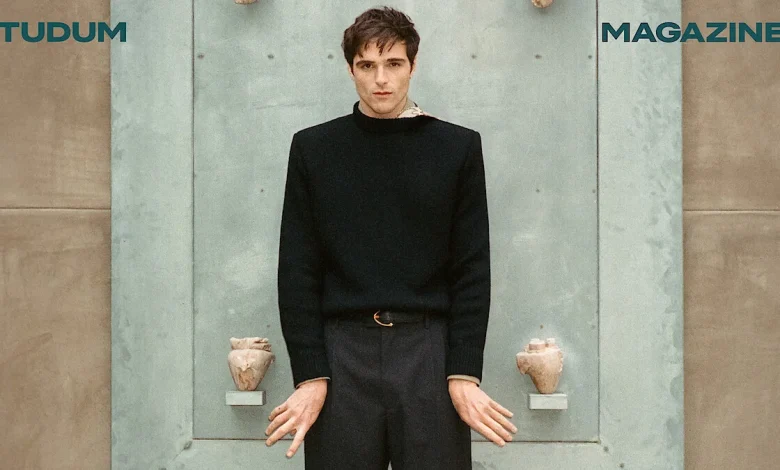Jacob Elordi Transcends with His Frankenstein Transformation

From the moment he got the call about playing the iconic monster in Guillermo del Toro’s Frankenstein, Jacob Elordi knew it was going to be “the biggest film” of his career so far. But the Australian actor was never intimidated by the monumental task ahead of him as he stepped into the world of the Oscar-winning filmmaker’s beloved story — there was a sense of trust from the beginning. “I wasn’t afraid, because I knew that Guillermo knew,” Elordi says. “I knew I didn’t have to tell him or show him.”
In del Toro’s visionary retelling of Mary Shelley’s classic novel, Elordi wholly transforms as he navigates the evolution of the Creature (as Frankenstein’s monster is known) from newborn being — forced into existence by scientist Victor Frankenstein (Oscar Isaac), who is fueled by hubris and obsession — to a mature individual who must judge his own maker. Elordi’s Creature evokes difficult questions about monsters and men; about creation and salvation.
“I’ll remember this [experience] forever. It completely reignited my passion for movies … I have a whole different energy toward making films now,” says the actor, who has been on a cinematic roll as of late, working with auteurs like Sofia Coppola (Priscilla), Paul Schrader (Oh, Canada), Emerald Fennell (Saltburn, which earned Elordi a BAFTA Film Award nomination for Supporting Actor), Justin Kurzell (in the sweeping limited series The Narrow Road to the Deep North), and Ridley Scott (in the forthcoming The Dog Stars). “My hope is that you feel something. Frankenstein is not to be watched idly.”
Jacob Elordi behind the scenes of Frankenstein.
Photograph by Ken Woroner
Frankenstein — a “gothic fairytale,” according to Elordi — is meant to be enjoyed with the same keen eye its creators applied to its production. Elordi studied everything from the avant-garde Japanese dance form of butoh to the movements of his golden retriever, Layla, to portray the Creature’s journey from wide-eyed naïveté to hardened existence. “The way Jacob plays him like a baby in the beginning is just wonderful, and then the way he moves like a man is so moving, and it’s all Jacob,” says del Toro. “Jacob came in fully formed with that.”
Elordi sat through hours of prosthetics application (Creature designer Mike Hill and his team created 42 separate pieces for Elordi’s character), donned fake dentures, and popped in a large brown contact lens to embody the character del Toro has revered since childhood. “From the moment I got into the makeup trailer [the performance] began, and it was alive,” Elordi says. “Guillermo said this would be not just a meditation, but a metamorphosis.” Now, the actor takes you inside his Frankenstein transformation.
Elordi documents his transformation into the Creature.
Photograph by Jacob Elordi
What was it like collaborating with Guillermo del Toro for Frankenstein?
Jacob Elordi: Working with Guillermo was a really profound experience; he creates a cinema of the soul. When Guillermo del Toro asks you to make a movie, there’s no decision-making process. It’s just, “Yes.”
Once you said yes to Frankenstein, how did you prepare?
Elordi: I had about four weeks to really get ready for production. There’s a point where you have to leave the world behind. You have to close all the doors to your house emotionally. You close your ears off and close your eyes off and change the way that you see things — all the regular things that you would do in a day, like eating and showering. They have to take on a new life to be able to shift into something else.
How did you and the Creature design team approach creating the character physically?
Elordi: Mike Hill is a genius. He loves Frankenstein as much as Guillermo does. I wanted to be as calm and as respectful of his process as I could be. The original drawings Mike did for this makeup are incredible — breathtaking. They make my eyes well up when I see how he draws, the anatomy of a recomposed human being. He’s genuinely one of the finest artists I’ve ever encountered.
Jacob Elordi photographs his journey making Frankenstein.
Photograph by Jacob Elordi
“When Guillermo del Toro asks you to make a movie, there’s no decision-making process. It’s just, ‘Yes,’ ” says Elordi.
Photograph by Jacob Elordi
Frankenstein’s mighty ship, which was created as a fully practical set with a built-out interior and exterior.
Photograph by Jacob Elordi
Oscar Isaac as Victor Frankenstein.
Photograph by Jacob Elordi
David Bradley as the Blind Man.
Photograph by Jacob Elordi
Behind the scenes of Guillermo del Toro’s Frankenstein.
Photograph by Jacob Elordi
Your vocal performance is so remarkable in this film. How did you find the Creature’s voice?
Elordi: The dentures I wore told me exactly what his voice was. I would go into my room and start doing these throat chants in the mirror. Then I put the teeth in, and the Creature just started speaking. There’s a composition of lots of different voices. He learns language from the blind man [played by David Bradley]. It’s hard to articulate a singular thing.
After all that preparation, how did your performance come together once you were on set?
Elordi: It was consuming. Your skin gets washed out and covered with something new. Your face, and its structure, change. Then you put the costume on and there’s leather and furs, and the weight — it’s all real. Finally, you walk through the studio doors. Inside, as far as you can see up, is this spire of a castle, and there’s snow falling from the ceiling, and the doors of the castle open, and there’s a fire burning inside. It’s an alive experience.
When Guillermo del Toro asks you to make a movie, there’s no decision-making process. It’s just, ‘Yes.’
Jacob Elordi
Which themes spoke to you throughout the filming process?
Elordi: It’s an exploration of the archetypal father–son relationship — physically, emotionally, and spiritually. Forgiveness is a key part of the film, and it’s a key part of the Creature’s journey in life. You can’t really move forward from a trauma until you’ve faced it and gone through the feelings and learned to forgive whatever caused that.
Through forgiveness, the Creature learns that he can finally be human. He can be a person, but the way he discovers that is not through violence or revenge. It’s through actually seeing another person, understanding them, and understanding his father’s flaws — that his father came from somewhere as well. We have three generations of men. You meet Victor’s father and see Victor acknowledge the terror that his father was. But then Victor becomes that terror. The Creature becomes the terror, too, but is able to take the trauma and turn it into something else.
Photograph by Jacob Elordi
What was it like working through those realizations alongside Guillermo del Toro and your co-stars Oscar Isaac, Mia Goth, and Christoph Waltz?
Elordi: It was necessary for me as a performer to come and do this with Guillermo. I needed to sit with someone to tell me that movies are so important. That this is heaven.
This cast is incredible. These are all heavy hitters and people that I’ve watched my whole life. Working with them was amazing. We just ripped our chests open and showed each other everything that we have. It’s like being in a candy shop. These actors are all my favorite sour worms.
A version of this feature originally appeared in Issue 22 of Tudum Magazine.





